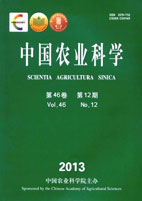-
Photosynthetic Physiology of Odontothrips Damaged Medicago sativa
- KOU Jiang-Tao, SHI Shang-Li, HU Gui-Xin, ZHOU Wan-Hai, YAO Tuo
-
Scientia Agricultura Sinica. 2013, 46(12):
2459-2470.
doi:10.3864/j.issn.0578-1752.2013.12.007
-
 Abstract
(
565 )
Abstract
(
565 )
 PDF (714KB)
(
808
)
PDF (714KB)
(
808
)
 Save
Save
-
References |
Related Articles |
Metrics
【Objective】Photosynthetic physiological response mechanism of alfalfa to thrips and compensational mechanism of thrip damage were studied.【Method】Thrip resistant clone R-1 and susceptible clone I-1 were used to investigate the changes of gas exchange parameter and kinetic parameter of chlorophyll fluorescence of differently damaged leaves of R-1 and I-1 at initial flower stage under continuous thrips damage.【Result】As the increase of leaf damage grade, the chlorophyll content and water use efficiency (WUE) increased, net photosynthetic rate (Pn) increased firstly, then decreased, while intracellular CO2 concentration (Ci), transpiration rate (Tr) and stomatal conductance (Gs) decreased. Light compensation point (Lcp), dark respiration rate (Rd), apparent quantum yield (AQY), light saturation point (Lsp), maximum net photosynthetic rate (Pnmax) increased firstly and then decreased in R-1, and for I-1, Lcp and Rd increased, AQY and Lsp decreased, Pnmax increased firstly and then decreased. Under the same damage level, Pn, AQY, Lsp and Pnmax of R-1 were higher than I-1, while Rd and Lcp were lower than I-1. As the increase of leaf damage grade, F0 of R-1 decreased firstly and then increased, photosynthetic efficiency of PSII (ФPSII), non-photochemical quenching coefficient (NPQ), photochemical quenching coefficient (qP), potential activity of PSII (Fv/F0) and original light energy transformation efficiency of PSII (Fv/Fm) increased firstly, then decreased, F0 of I-1 increased, while NPQ and qP increased firstly, then decreased, ФPSII, actual Fv/F0, and Fv/Fm decreased. Under the same damage grade, R-1 was found with lower F0 and higher ФPSII, qP, Fv/F0 and Fv/Fm, compared with I-1. Comparatively, gas exchange parameter, light response parameter and kinetic parameter of chlorophyll fluorescence fluctuations of R-1 were all less than that of I-1. 【Conclusion】Alfalfa PSII reaction center was injured due to thrip damage, which resulted in a decreased photosynthetic efficiency, indicating that R-1 was with a higher photosynthetic efficiency and a more effective photosynthetic compensation efficiency under minor thrip damage compared with I-1, as well as a relatively stronger resistance against thrip damage.









